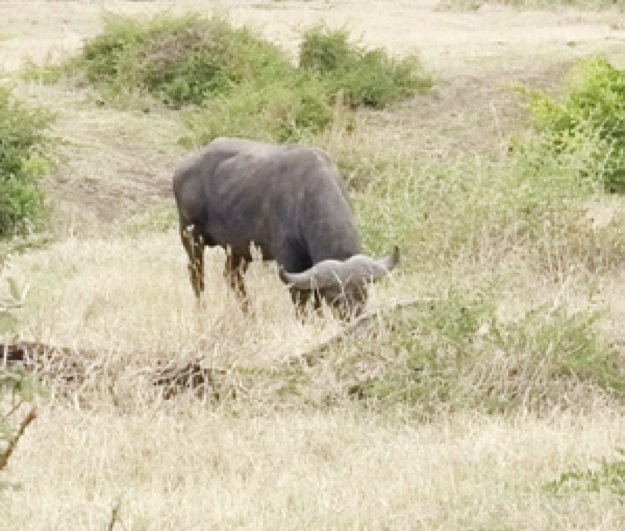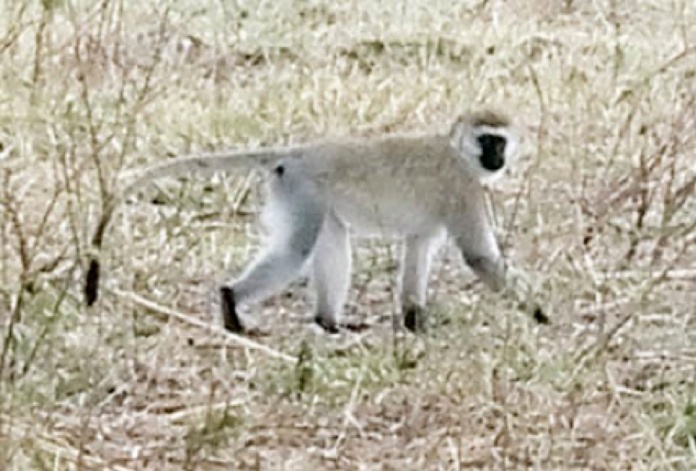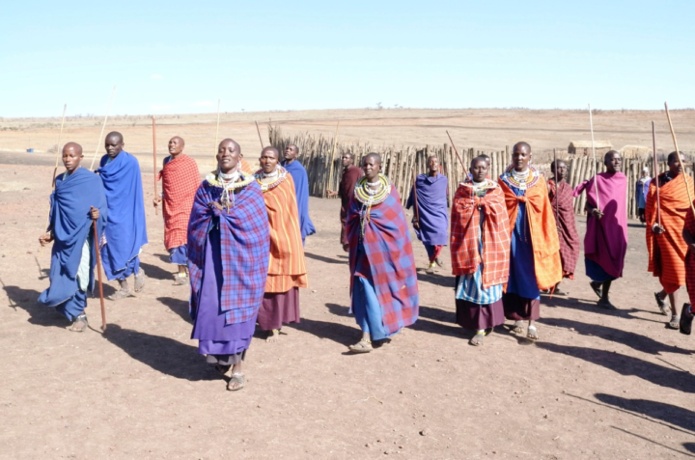Today was our day to descend to the crater floor, a set apart realm containing thousands of animals of many species. Dividing up into several Landcruisers, our group had to transit along the crater ridge to the down going road on the far side. Unlike the crater floor, the ridge is well watered and somewhat forested. This zebra found it pleasant:
Down on the crater floor, our driver, Steven, opened the roof of our vehicle to permit us to stand and take photographs.
Unfortunately, my small Leica camera, so easy to carry and generally useful lacks a telephoto lens, so some of my photos have had to be digitally zoomed, reducing quality. These shots of warthogs, an ostrich, a Cape buffalo (said to be one of the most dangerous animals in the crater) and a hyena illustrate the problem:
At a bathroom stop, a vervet monkey managed to snatch some food off the hood of a nearby Landcruiser. Here, he looks back with a measure of contempt:
Sometimes we got close enough for my camera to do its thing, as this photo of a wildebeest shows. Wildebeests are among the most numerous animals both here and in the Serengeti. They are a major food source for top predators like the lion. Not a lovely species, but apparently a very successful one.
In a small wooded area below our track, I snapped this beautiful serval cat
And this elephant with its baby:
Passing a length of reeds in a watered area, we saw this lazy fellow:
Traveling on, we encountered many of the ruminants that provide lions with their food. Not far away, a placidly grazing herd of zebras. The brownish ones are either females or younger males:
A Grant’s gazelle . . .
and a Thompson (“Tommy”) gazelle
Finally, in small pool made by a brook, a herd of hippos:
We returned to the Lodge for lunch and then, at 3:00 PM, a smaller group of us visited a nearby Masai village. As we walked toward their fenced in compound, a group of men greeted us
As did the chief
and a group of women
One of whom is tending her infant
The men put on a dance exhibition (marked by enthusiastic solo jumping) . . .
Showed off their elegant “Michelin” sandals:
And skills of twisting sticks until there was enough heat to start a fire:
The visit included a tour of a Masai wood and cow dung home:
It ended after a display of Masai tourist goods. This woman was obviously skeptical of our claim that we could pay no more for some trinket:
The day ended with a fascinating lecture before dinner by Ingela Jansson of the Serengeti Lion Project. Ingela (a Swedish woman) described the efforts the project is making to stabilize the declining populations of lions in this region. Among other things, this involves tracking lion movements between the Serengeti and the crater (using GPS collars) and also assessing the lions’ physical and reproductive health.
The Project is making a major effort, as well, to persuade the Masai to protect the lions. Traditionally, a male Masai came of age by spearing and killing a lion. Lions also attack the Masai’s cows, an additional reason why the Masai have hunted the predator. (Ingela reported that not long ago, she was tracking a collared female when her computer showed the animal stopping and then moving rapidly away. Going to the site, she found the lion dead and its collar gone. A group of Masai were sighted in the distance running off with the collar.) But the Masai realize that they and the region need a stable and healthy population of lions. Building on this, the Project has recruited the best lion warriors of the Masai and given them responsibility for monitoring and protecting their own groups of lions. These individuals are dubbed “Lion Defenders,” a title and honor that they seem to greatly value. Thus, masculine courage and knowledge of this species is being redirected to the animals’ protection.






























